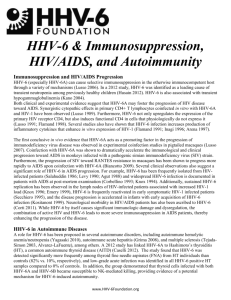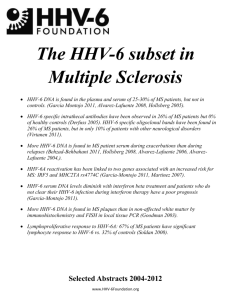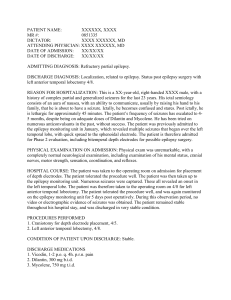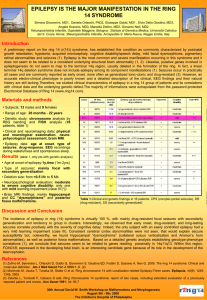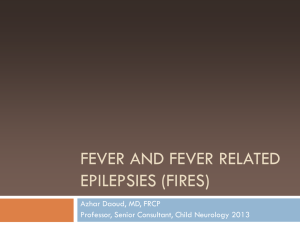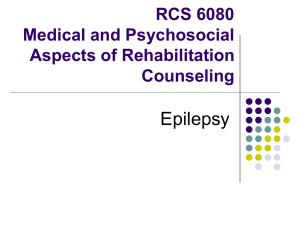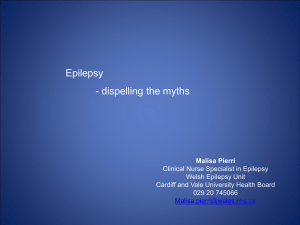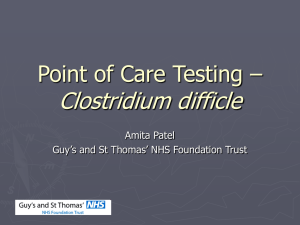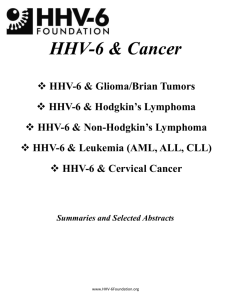Selected Abstracts 2006-2012 - HHV
advertisement
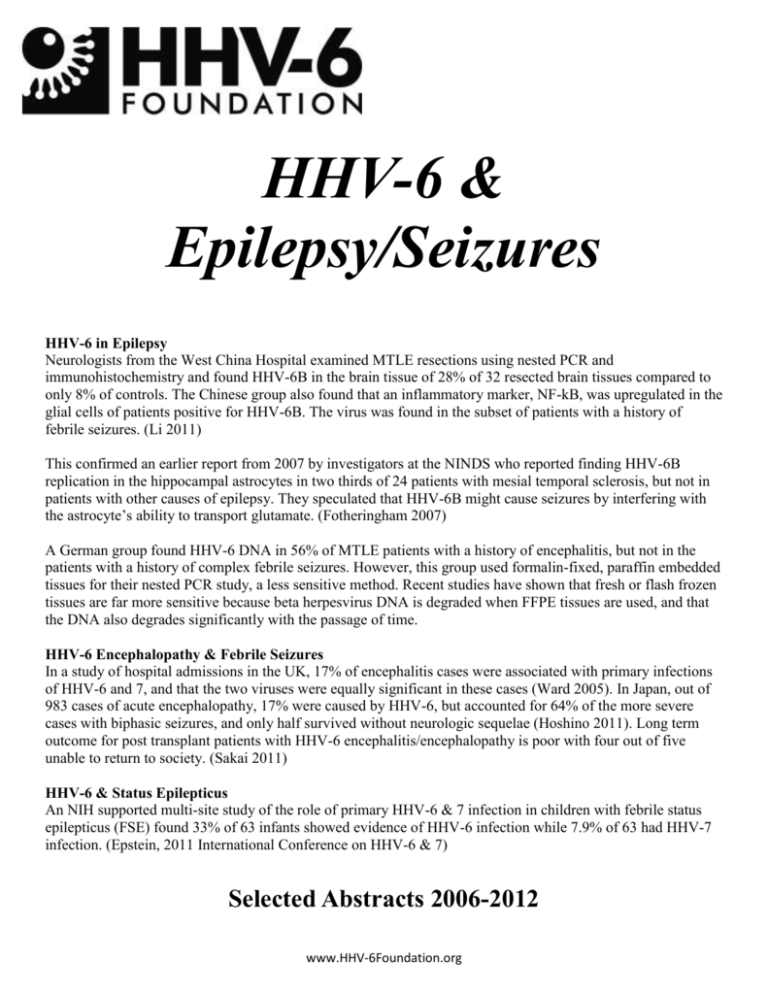
HHV-6 & Epilepsy/Seizures HHV-6 in Epilepsy Neurologists from the West China Hospital examined MTLE resections using nested PCR and immunohistochemistry and found HHV-6B in the brain tissue of 28% of 32 resected brain tissues compared to only 8% of controls. The Chinese group also found that an inflammatory marker, NF-kB, was upregulated in the glial cells of patients positive for HHV-6B. The virus was found in the subset of patients with a history of febrile seizures. (Li 2011) This confirmed an earlier report from 2007 by investigators at the NINDS who reported finding HHV-6B replication in the hippocampal astrocytes in two thirds of 24 patients with mesial temporal sclerosis, but not in patients with other causes of epilepsy. They speculated that HHV-6B might cause seizures by interfering with the astrocyte’s ability to transport glutamate. (Fotheringham 2007) A German group found HHV-6 DNA in 56% of MTLE patients with a history of encephalitis, but not in the patients with a history of complex febrile seizures. However, this group used formalin-fixed, paraffin embedded tissues for their nested PCR study, a less sensitive method. Recent studies have shown that fresh or flash frozen tissues are far more sensitive because beta herpesvirus DNA is degraded when FFPE tissues are used, and that the DNA also degrades significantly with the passage of time. HHV-6 Encephalopathy & Febrile Seizures In a study of hospital admissions in the UK, 17% of encephalitis cases were associated with primary infections of HHV-6 and 7, and that the two viruses were equally significant in these cases (Ward 2005). In Japan, out of 983 cases of acute encephalopathy, 17% were caused by HHV-6, but accounted for 64% of the more severe cases with biphasic seizures, and only half survived without neurologic sequelae (Hoshino 2011). Long term outcome for post transplant patients with HHV-6 encephalitis/encephalopathy is poor with four out of five unable to return to society. (Sakai 2011) HHV-6 & Status Epilepticus An NIH supported multi-site study of the role of primary HHV-6 & 7 infection in children with febrile status epilepticus (FSE) found 33% of 63 infants showed evidence of HHV-6 infection while 7.9% of 63 had HHV-7 infection. (Epstein, 2011 International Conference on HHV-6 & 7) Selected Abstracts 2006-2012 www.HHV-6Foundation.org HHV-6 & EPILEPSY/SEIZURES Detection of human herpes virus 6B in patients with mesial temporal lobe epilepsy in West China and the possible association with elevated NF-κB expression. Li JM, Lei D, Peng F, Zeng YJ, Li L, Xia ZL, Xia XQ, Zhou D. Department of Neurology, West China Hospital of Sichuan University, Chengdu, Sichuan 610041, China. Epilepsy Res. 2011 Mar;94(1-2):1-9. There has been a long-standing suspicion that an association exists between mesial temporal lobe epilepsy (MTLE) and the herpes virus. Evidence for HHV-6B involvement has been reported. However, no investigation has been performed in China. We used nested PCR and immunohistochemistry to detect viral DNA of human herpes virus (HHV)-6B, HHV-6A, herpes simplex virus (HSV)-1 and HSV-2 in resected brain tissues from patients with MTLE and control. A principal transcription factor, NF-κB, that is associated with the inflammatory response was also investigated by real-time PCR, western blotting and immunohistochemistry. HHV-6B DNA was detected in hippocampal samples from 9 out of 32 (28.1%) patients with MTLE and in 1 of 12 (8.3%) control samples. Immunoreactivity for HHV-6B was consistently present in MTLE patients positive for HHV6 detected by PCR. Significant staining for HHV-6B antigen was distributed mainly around or in the nucleus of cells that morphologically resembled astrocytes and microglia. HHV-6B positivity was related to febrile convulsion history of patients with MTLE. The expression of NF-κB was up-regulated and distributed in the nucleus of glial cells in MTLE patients positive for HHV-6B.This study was first to find HHV-6B in MTLE patients from West China and demonstrate a possible association between HHV-6B positivity and activation of NF-κB. The detailed role of HHV-6B and its association with NF-κB in the development of chronic MTLE requires further investigation. The Role of Human Herpesvirus 6 and 7 in Febrile Status Epilepticus: The FEBSTAT study Leon Epstein, MD Northwestern University Feinberg School of Medicine, Chicago, IL, USA. Presented at the February 2011 International Conference on HHV-6 & 7 in Reston, Virginia http://www.scivee.tv/node/28412 In a prospective study of the consequences of prolonged febrile seizures (FEBSTAT), we determined the frequency of Human Herpesvirus (HHV)-6 and HHV-7 infection as a cause of febrile status epilepticus (FSE). Children ages 1 month to 5 years presenting with FSE were enrolled within 72 hours and received a comprehensive assessment including specimens for HHV-6 and HHV-7. The presence of HHV-6A, HHV-6B or HHV-7 DNA and RNA (amplified across a spliced junction) determined using quantitative polymerase chain reaction (qPCR) at baseline indicated viremia. Antibody titers to HHV-6 and HHV-7 were used in conjunction with the PCR results to distinguish primary infection from reactivated or prior infection. Of 198 children evaluated, HHV-6 or HHV-7 status could be determined in 168 (84.8%). HHV-6B viremia at baseline was found in 53 subjects (31.6%), including 37 with primary infection and 16 with reactivated infection. No HHV-6A infections were identified. HHV-7 viremia at baseline was observed in 12 (7.1%) subjects, including 8 with primary infection and 4 with reactivated infection. Two subjects had HHV-6/HHV-7 coinfection at baseline. HHV-6B infection is the most common cause of FSE. HHV-7 infection is a less frequent cause of FSE. Together, they account for one third of FSE, a condition associated with an increased risk of both hippocampal injury and subsequent temporal lobe epilepsy. Association of human herpesvirus-6B with mesial temporal lobe epilepsy. Fotheringham J, Donati D, Akhyani N, Fogdell-Hahn A, Vortmeyer A, Heiss JD, Williams E, Weinstein S, Bruce DA, Gaillard WD, Sato S, Theodore WH, Jacobson S. Viral Immunology Section, National Institute of Neurological Disorders and Stroke, National Institutes of Health, Bethesda, Maryland, United States of America. PLoS Med. 2007 May;4(5):e180. Human herpesvirus-6 (HHV-6) is a beta-herpesvirus with 90% seroprevalence that infects and establishes latency in the central nervous system. Two HHV-6 variants are known: HHV-6A and HHV-6B. Active infection or reactivation of HHV-6 in the brain is associated with neurological disorders, including epilepsy, encephalitis, and multiple sclerosis. In a www.HHV-6Foundation.org 2 HHV-6 & EPILEPSY/SEIZURES preliminary study, we found HHV-6B DNA in resected brain tissue from patients with mesial temporal lobe epilepsy (MTLE) and have localized viral antigen to glial fibrillary acidic protein (GFAP)-positive glia in the same brain sections. We sought, first, to determine the extent of HHV-6 infection in brain material resected from MTLE and non-MTLE patients; and second, to establish in vitro primary astrocyte cultures from freshly resected brain material and determine expression of glutamate transporters. HHV-6B infection in astrocytes and brain specimens was investigated in resected brain material from MTLE and nonMTLE patients using PCR and immunofluorescence. HHV-6B viral DNA was detected by TaqMan PCR in brain resections from 11 of 16 (69%) additional patients with MTLE and from zero of seven (0%) additional patients without MTLE. All brain regions that tested positive by HHV-6B variant-specific TaqMan PCR were positive for viral DNA by nested PCR. Primary astrocytes were isolated and cultured from seven epilepsy brain resections and astrocyte purity was defined by GFAP reactivity. HHV-6 gp116/54/64 antigen was detected in primary cultured GFAP-positive astrocytes from resected tissue that was HHV-6 DNA positive-the first demonstration of an ex vivo HHV-6-infected astrocyte culture isolated from HHV-6-positive brain material. Previous work has shown that MTLE is related to glutamate transporter dysfunction. We infected astrocyte cultures in vitro with HHV-6 and found a marked decrease in glutamate transporter EAAT-2 expression. Overall, we have now detected HHV-6B in 15 of 24 patients with mesial temporal sclerosis/MTLE, in contrast to zero of 14 with other syndromes. Our results suggest a potential etiology and pathogenic mechanism for MTLE. Presence of human herpes virus 6 DNA exclusively in temporal lobe epilepsy brain tissue of patients with history of encephalitis. Niehusmann P, Mittelstaedt T, Bien CG, Drexler JF, Grote A, Schoch S, Becker AJ. Department of Neuropathology, University of Bonn Medical Center, Bonn, Germany. pittniehusmann@uni-bonn.de Epilepsia. 2010 Dec;51(12):2478-83. Temporal lobe epilepsy (TLE) is frequently associated with mesial temporal sclerosis (MTS). Many etiologic aspects of TLE are still unresolved. Here, we aimed to analyze the presence of human herpes virus 6 (HHV-6) DNA in distinct TLE pathologies. Nested polymerase chain reaction (PCR) in surgical tissue from 38 pharmaco-resistant TLE patients and 10 autopsy controls revealed HHV-6 DNA in 55.6% of the TLE patients with a history of encephalitis, involving MTS and gliotic hippocampi without substantial neurodegeneration, but not in lesion-associated TLE or nonlesional MTS with or without a history of complex febrile seizures (CFS). HHV-6 protein was present in only one patient's tissue. Our data argue against HHV-6 as a major local pathogenetic factor in MTS hippocampi after CFS. The high detection rate of HHV-6 DNA suggests a potential pathogenetic role of HHV-6 in TLE patients with a history of encephalitis. [Note: PCR on FFPE tissue is not as sensitive as PCR on fresh tissue or immunohistochemistry due to degradation of DNA.] Investigation of HSV-1, HSV-2, CMV, HHV-6 and HHV-8 DNA by real-time PCR in surgical resection materials of epilepsy patients with mesial temporal lobe sclerosis. Karatas H, Gurer G, Pinar A, Soylemezoglu F, Tezel GG, Hascelik G, Akalan N, Tuncer S, Ciger A, Saygi S. Hacettepe University, Faculty of Medicine, Department of Neurology, Sihhiye, Ankara, 06100, Turkey. hulyak@hacettepe.edu.tr J Neurol Sci. 2008 Jan 15;264(1-2):151-6. The objective of this study is to investigate the presence of viral DNAs of HSV-1, HSV-2, HHV-6, HHV-8, and CMV in hippocampus of the patients with mesial temporal lobe epilepsy (MTLE) syndrome. Pathological specimens were obtained from 33 patients with MTLE undergone temporal lobectomy with amygdalo-hippocampectomy due to intractable seizures. Autopsy materials from the hippocampus of 7 patients without neurological disease were used as controls. The data was also correlated with the clinical history of patients including febrile convulsions, age, and history of CNS infections. Real-time polymerase chain reaction method was performed for detection of DNAs of these viruses. HHV-6, HSV-1 and HHV-8 were detected in the hippocampus of 3, 2 and 1 patients with MTLE respectively. None of the hippocampus of patients with MTLE was positive for DNA of HSV-2 and/or CMV. Three patients with positive HHV-6 DNAs had febrile convulsions and family history for epilepsy. None of our control specimens showed PCR positivity to any of the 5 tested viruses. Our study is the first to report the presence of HHV-8 viral genome in the brain tissue of patient with MTLE. Viral DNAs were detected in a total of 18% of the patients in this study; we can conclude that www.HHV-6Foundation.org 3 HHV-6 & EPILEPSY/SEIZURES activity of the latent virus in patients with hippocampal sclerosis should be more extensively studied to establish its role in active infection. Detection of human herpesvirus-6 in mesial temporal lobe epilepsy surgical brain resections. Donati D, Akhyani N, Fogdell-Hahn A, Cermelli C, Cassiani-Ingoni R, Vortmeyer A, Heiss JD, Cogen P, Gaillard WD, Sato S, Theodore WH, Jacobson S. Neuroimmunology Branch, National Institute of Neurological Disorders and Stroke, NIH, Bethesda, MD 20892, USA. Neurology. 2003 Nov 25;61(10):1405-11. Human herpesvirus-6 (HHV-6), a ubiquitous beta-herpesvirus, is the causative agent of roseola infantum and has been associated with a number of neurologic disorders including seizures, encephalitis/meningitis, and multiple sclerosis. Although the role of HHV-6 in human CNS disease remains to be fully defined, a number of studies have suggested that the CNS can be a site for persistent HHV-6 infection. To characterize the extent and distribution of HHV-6 in human glial cells from surgical brain resections of patients with mesial temporal lobe epilepsy (MTLE). Brain samples from eight patients with MTLE and seven patients with neocortical epilepsy (NE) undergoing surgical resection were quantitatively analyzed for the presence of HHV-6 DNA using a virus-specific real-time PCR assay. HHV6 expression was also characterized by western blot analysis and in situ immunohistochemistry (IHC). In addition, HHV6-reactive cells were analyzed for expression of glial fibrillary acidic protein (GFAP) by double immunofluorescence. DNA obtained from four of eight patients with MTLE had significantly elevated levels of HHV-6 as quantified by realtime PCR. HHV-6 was not amplified in any of the seven patients with NE undergoing surgery. The highest levels of HHV-6 were demonstrated in hippocampal sections (up to 23,079 copies/10(6) cells) and subtyped as HHV-6B. Expression of HHV-6 was confirmed by western blot analysis and IHC. HHV-6 was co-localized to GFAP-positive cells that morphologically appeared to be astrocytes. HHV-6B is present in brain specimens from a subset of patients with MTLE and localized to astrocytes in the absence of inflammation. The amplification of HHV-6 from hippocampal and temporal lobe astrocytes of MTLE warrants further investigation into the possible role of HHV-6 in the development of MTLE. Presence of human herpesvirus 6 and herpes simplex virus detected by polymerase chain reaction in surgical tissue from temporal lobe epileptic patients. Uesugi H, Shimizu H, Maehara T, Arai N, Nakayama H. Department of Psychiatry, National Center Hospital for Mental, Nervous, and Muscular Disorders, Kodaira, Tokyo, Japan.Psychiatry Clin Neurosci. 2000 Oct;54(5):589-93. We investigated the presence of human herpesvirus 6 (HHV-6) and herpes simplex virus (HSV) in surgical tissue from temporal lobe epileptic patients. A total of 17 cases were studied, including eight males and nine females. The mean age was 24.9 +/- 11.1 years and the mean age of onset was 11.1 +/- 5.4 years. Five patients were diagnosed as encephalitis/meningitis and another three had a history of suspected encephalitis/meningitis, but no patient showed any obvious neurological symptom or mental handicap. Mesial and lateral temporal tissues were examined by polymerase chain reaction. Among six patients positive for HHV-6 (35%), the mesial temporal lobe was positive in four and the lateral temporal lobe was positive in three. Herpes simplex virus was positive in only one patient. Three of the six patients positive for HHV-6 did not show any apparent causes. Mild encephalitis/meningitis induced by HHV-6, a condition sometimes not recognized as encephalitis/meningitis, may be one of the most frequent causes of temporal lobe epilepsy. Association of human herpesvirus-6B with mesial temporal lobe epilepsy. Fotheringham J, Donati D, Akhyani N, Fogdell-Hahn A, Vortmeyer A, Heiss JD, Williams E, Weinstein S, Bruce DA, Gaillard WD, Sato S, Theodore WH, Jacobson S. Viral Immunology Section, National Institute of Neurological Disorders and Stroke, National Institutes of Health, Bethesda, Maryland, United States of America. PLoS Med. 2007 May;4(5):e180. www.HHV-6Foundation.org 4 HHV-6 & EPILEPSY/SEIZURES Human herpesvirus-6 (HHV-6) is a beta-herpesvirus with 90% seroprevalence that infects and establishes latency in the central nervous system. Two HHV-6 variants are known: HHV-6A and HHV-6B. Active infection or reactivation of HHV-6 in the brain is associated with neurological disorders, includingepilepsy, encephalitis, and multiple sclerosis. In a preliminary study, we found HHV-6B DNA in resected brain tissue from patients with mesial temporal lobe epilepsy(MTLE) and have localized viral antigen to glial fibrillary acidic protein (GFAP)-positive glia in the same brain sections. We sought, first, to determine the extent ofHHV-6 infection in brain material resected from MTLE and non-MTLE patients; and second, to establish in vitro primary astrocyte cultures from freshly resected brain material and determine expression of glutamate transporters. HHV-6B infection in astrocytes and brain specimens was investigated in resected brain material from MTLE and nonMTLE patients using PCR and immunofluorescence. HHV-6B viral DNA was detected by TaqMan PCR in brain resections from 11 of 16 (69%) additional patients with MTLE and from zero of seven (0%) additional patients without MTLE. All brain regions that tested positive by HHV-6B variant-specific TaqMan PCR were positive for viral DNA by nested PCR. Primary astrocytes were isolated and cultured from seven epilepsy brain resections and astrocyte purity was defined by GFAP reactivity. HHV-6gp116/54/64 antigen was detected in primary cultured GFAP-positive astrocytes from resected tissue that was HHV-6 DNA positive-the first demonstration of an ex vivo HHV-6-infected astrocyte culture isolated from HHV-6-positive brain material. Previous work has shown that MTLE is related to glutamate transporter dysfunction. We infected astrocyte cultures in vitro with HHV-6 and found a marked decrease in glutamate transporter EAAT-2 expression. Overall, we have now detected HHV-6B in 15 of 24 patients with mesial temporal sclerosis/MTLE, in contrast to zero of 14 with other syndromes. Our results suggest a potential etiology and pathogenic mechanism for MTLE. Febrile seizures and primary human herpesvirus 6 infection. Laina I, Syriopoulou VP, Daikos GL, Roma ES, Papageorgiou F, Kakourou T, Theodoridou M. First Department of Pediatrics, Aghia Sophia Children's Hospital, Athens University, Athens, Greece. Pediatr Neurol. 2010 Jan;42(1):28-31. Primary human herpesvirus 6 infection is acquired mainly during the first two years of life and is often associated with febrile seizures. The aim of the present study was to investigate in Greece the frequency and clinical characteristics of primary human herpesvirus 6 (HHV-6) infection in hospitalized children with febrile seizures. Children aged from 6 months to 5 years without known neurologic disease were examined for primary HHV-6 infection, by real-time polymerase chain reaction in acute-phase plasma and by indirect immunofluorescent assay for antibody titers in acute and convalescent serum. Of 65 children included in the analysis, 55 experienced the first febrile episode of seizures and 10 the second. Primary HHV-6 infection was verified in 10 of 55 children with a first febrile episode (18%), whereas none of the 10 children with a second episode of seizures had primary HHV-6 infection. Eight children were infected with HHV6 type B and two with type A. None of the 85 control subjects had primary HHV-6 infection, but 49% had immunoglobulin G antibodies against the virus. These findings suggest that primary HHV-6 infection is frequently associated with febrile seizures in children in this geographic region and should be considered, especially for a first episode of febrile seizures. Human herpesviruses-6 and -7 each cause significant neurological morbidity in Britain and Ireland. Ward KN, Andrews NJ, Verity CM, Miller E, Ross EM. Department of Virology, Royal Free and University College Medical School, Windeyer Institute of Medical Sciences, London, UK. k.n.ward@ucl.ac.uk Arch Dis Child. 2005 Jun;90(6):619-23. Primary human herpesvirus-6 and -7 (HHV-6/-7) infections cause febrile illness sometimes complicated by convulsions and rarely encephalopathy. In a three year prospective study in Britain and Ireland, 205 children (2-35 months old) hospitalised with suspected encephalitis and/or severe illness with fever and convulsions were reported via the British Paediatric Surveillance Unit network. Blood samples were tested for primary HHV-6 and -7 infections. 26/156 (17%) of children aged 2-23 months had primary infection (11 HHV-6; 13 HHV-7; two with both viruses) coinciding with the www.HHV-6Foundation.org 5 HHV-6 & EPILEPSY/SEIZURES acute illness; this was much higher than the about three cases expected by chance. All 26 were pyrexial; 25 had convulsions (18 status epilepticus), 11 requiring ventilation. Median hospital stay was 7.5 days. For HHV-6 primary infection the median age was 53 weeks (range 42-94) and the distribution differed from that of uninfected children; for HHV-7, the median was 60 weeks (range 17-102) and the distribution did not differ for the uninfected. Fewer (5/15) children with primary HHV-7 infection had previously been infected with HHV-6 than Primary HHV-6 and HHV-7 infections accounted for a significant proportion of cases in those <2 years old of severe illness with fever and convulsions requiring hospital admission; each virus contributed equally. Predisposing factors are age for HHV-6 and no previous infection with HHV-6 for HHV-7. Children with such neurological disease should be investigated for primary HHV-6/7 infections, especially in rare cases coinciding by chance with immunisation to exclude misdiagnosis as vaccine reactions. A major role of viruses in convulsive status epilepticus in children: a prospective study of 22 children. Juntunen A, Herrgård E, Mannonen L, Korppi M, Linnavuori K, Vaheri A, Koskiniemi M. Department of Paediatrics, Kuopio University Hospital, Finland. Eur J Pediatr. 2001 Jan;160(1):37-42. A group of 22 previously healthy children with their first convulsive status epilepticus (SE), treated at Kuopio University Hospital, Finland, were prospectively studied. Eleven children had febrile and 11 afebrile SE. Polymerase chain reaction was used to detect specific DNA from CSF, enzyme immunoassays and immunofluorescence assays to detect specific antibodies in serum and CSF, viral cultures were obtained from CSF, throat and stool and antigen detection from throat specimens. Viral infection was identified in 10 of 11 children with febrile SE (91%) and in 7 of 11 with afebrile SE (64%). Human herpes virus 6 infection was identified in 12 children (55%), and in at least six of them the infection was primary. Single cases of human herpes virus 7, parainfluenza 3, adenovirus 1, echovirus 22, rota, influenza A and Mycoplasma pneumoniae infection were diagnosed. Viruses, human herpes virus 6 in particular, seem to be major associated factors in convulsive status epilepticus, both febrile and afebrile. Human herpes virus 7 and Mycoplasma pneumoniae are novel agents associated with status epilepticus. Role of viral infections in the etiology of febrile seizures. Millichap JG, Millichap JJ. Division of Neurology, Children's Memorial Hospital, Northwestern University Medical School, Chicago, Illinois 60614, USA. gmillichap@childrensmemorial.org Pediatr Neurol. 2006 Sep;35(3):165-72. The role of viral infection in the etiology of febrile seizures is a relatively neglected field of neurologic research. A National Institutes of Health Consensus Conference (1981) omitted reference to causes of infections and the role of fever in febrile seizures, and emphasized outcome and anticonvulsant treatment. In an earlier review of the world literature (1924-1964), except for roseola infantum, viral infections as a cause of febrile seizures were rarely diagnosed. The present review includes reports of viruses most commonly associated with febrile seizures in the last decade, especially human herpesvirus-6 and influenza. The specificity and neurotropic properties of some viruses in the febrile seizure mechanism, a possible encephalitic or encephalopathic pathology, and the essential role of fever and height of the body temperature as a measure of the febrile seizure threshold are discussed. Cytokine and immune response to infection, and a genetic susceptibility to febrile seizures are additional etiologic factors. Future research should emphasize early detection of causative viruses, the nature of viral neurotropism, and the role of cytokines in fever induction. Trials of antiviral agents and vaccines, with attention to safety concerns, and more effective antipyretics would address the febrile seizure mechanism more specifically than anticonvulsant therapies. www.HHV-6Foundation.org 6
